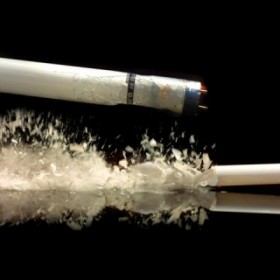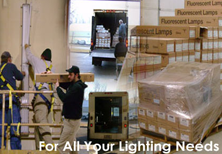Replacing Shatterproof Fluorescent Tubes with LED T8 Tubes
There are already numerous reasons to get rid of your old T8 and T12 fluorescent tubes and replace them with LED. From energy and maintenance savings to better light quality, longer life span and more controls. But one factor that makes the decision absolutely vital in some industries is the fact that many of the LED T8 tubes on the market are shatterproof.
Why is this important? Federal and state regulations require shatterproof lighting be maintained in food processing buildings, elevators, daycare centers and more. Then there are other companies in the packaging and container supply sector that are required by their customers to use protective lighting.
Prior to the rise in popularity of LED T8 tubes, companies in the situation mentioned above had to outfit their building fixtures with shatterproof fluorescent lighting. Shatterproof fluorescent tube lighting costs a lot up-front compared to standard fluorescent tube lighting. This contributes to whittling away one of the main advantages for fluorescent tube lighting over LED – cost difference.
Some LED T8 tubes come in glass and others in plastic/aluminum. While glass LED tubes have their use, they are not shatterproof so they are not a consideration for this application. Other LED tubes are constructed with a combination of plastic and aluminum. Plastic LED tubes tend to last longer than glass LED tubes even without factoring in the propensity for breaking, as the aluminum is strong and acts as a conductor of heat away from other components of the tube.
Relative to shatterproof fluorescent tubes, plastic LED tubes last anywhere from 2-4 times longer. They also use 30% less energy. LED tubes do not contain mercury and other dangerous materials. With their price continuing to drop closer to fluorescents, the time is ripe to make the switch from expensive fluorescent shatterproof tubes to LED T8 lighting.
At Premier Lighting we have customers with varying needs and in turn we carry one of the largest selections of LED T8 tubes, both in glass and plastic, to ensure we can meet each customer’s unique needs. If you have any questions about switching from shatterproof fluorescent tube lighting to LED T8’s, just contact us and we will find the ideal solution for your facility.




Please give me information about T8 connection for substitute normal light tube.
Is it need some converter unit?
I am really interested in getting more info about all your Led products. I have my own Led store in Puerto Rico and I want to buy to you for my inventory.
i am very interested in changing out my existing t8 tubes with shatterproof led tubes. please contact me at 818 232 2216
I understand the heat dissipation difference between a glass envelope and a plastic one as a plastic envelope can be molded around the heat sink, whereas a glass envelope would tend to totally enclose the led array. However, my concern is the yellowing and crazing that is common to plastics resulting in at least a change in light quality if not quantity over the life of the lamp. Also missing from a lot of led specifications is light output graphed over a period of time. What is the light output maintenance of typical led lamps?
Good thoughts Randy. As this article is over a year old, things have changed a bit. Probably the most common construction now for an LED T8 is coated glass. This reduces likely of damage while maintaining the benefits of glass. Namely, a cheaper cost and a wider beam spread in the 200°-240° range as opposed to 120° for plastic. As for light output maintenance. You will hear lighting manufacturers reference 50,000 at L70 – meaning the LED still has 70% of it’s light output at 50,000 hours. Newer LED products looking to be classified as DLC Premium now deliver 80% of it’s lumens at 50,000 hours.